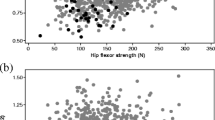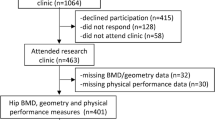Abstract
Studies examining the association between muscle size, muscle strength, and bone mineral density (BMD) are limited. Thus, this study aimed to describe the association between hip muscles cross-sectional area (CSA), muscle strength, and BMD of the hip and spine. A total of 321 subjects from the Tasmanian Older Adult Cohort study with a right hip MRI scan conducted between 2004 and 2006 were included. Hip muscles were measured on MR images by OsiriX (Geneva) software measuring maximum muscle CSA (cm2) of gluteus maximus, obturator externus, gemelli, quadratus femoris, piriformis, pectineus, sartorius, and iliopsoas. Dual-energy X-ray absorptiometry measured total hip, femoral neck, and spine BMD, and lower limb muscle strength was assessed by dynamometer. Muscle CSA of the hip flexors (pectineus, sartorius, and iliopsoas) and the hip rotators, obturator externus, and quadratus femoris were associated with both total hip and femoral neck BMD (all p < 0.05). The associations between CSA of pectineus and sartorius and BMD were stronger in women (p = 0.01–0.001) compared to men (p = 0.12–0.54). Additionally, only gemelli CSA was associated with BMD of the spine (p = 0.002). Gluteus maximus and piriformis showed no relationship with BMD. CSA of most hip muscles (except gluteus maximus and gemelli) were positively associated with leg strength (p = 0.02 to <0.001). Lastly, leg strength was weakly associated with BMD (p = 0.11–0.007). Hip muscle CSA, and to a lesser extent muscle strength, were positively associated with hip BMD. These data suggest that both higher muscle mass and strength may contribute to the maintenance of bone mass and prevention of disease progression in older adults.


Similar content being viewed by others
References
Blain H, Jaussent A, Thomas E, Micallef JP, Dupuy AM, Bernard PL, Mariano-Goulart D, Cristol JP, Sultan C, Rossi M, Picot MC (2010) Appendicular skeletal muscle mass is the strongest independent factor associated with femoral neck bone mineral density in adult and older men. Exp Gerontol 45:679–684
Szulc P, Blaizot S, Boutroy S, Vilayphiou N, Boonen S, Chapurlat R (2013) Impaired bone microarchitecture at the distal radius in older men with low muscle mass and grip strength: the STRAMBO study. J Bone Miner Res 28:169–178
Lebrasseur NK, Achenbach SJ, Melton LJ, Amin S, Khosla S (2012) Skeletal muscle mass is associated with bone geometry and microstructure and serum insulin-like growth factor binding protein-2 levels in adult women and men. J Bone Miner Res 27:2159–2169
Scott D, Blizzard L, Fell J, Jones G (2012) Prospective study of self-reported pain, radiographic osteoarthritis, sarcopenia progression, and falls risk in community-dwelling older adults. Arthritis Care Res 64:30–37
Johannesdottir F, Aspelund T, Siggeirsdottir K, Jonsson BY, Mogensen B, Sigurdsson S, Harris TB, Gudnason VG, Lang TF, Sigurdsson G (2012) Mid-thigh cortical bone structural parameters, muscle mass and strength, and association with lower limb fractures in older men and women (AGES-Reykjavik Study). Calcif Tissue Int 90:354–364
Abellan Van Kan G (2009) Epidemiology and consequences of sarcopenia. J Nutr Health Aging 13:708–712
Lang T, Cauley JA, Tylavsky F, Bauer D, Cummings S, Harris TB; Health ABC Study (2010) Computed tomographic measurements of thigh muscle cross-sectional area and attenuation coefficient predict hip fracture: the health, aging, and body composition study. J Bone Miner Res 25:513–519
Kim JH, Choi SH, Lim S, Lim JY, Kim KW, Park KS, Shin CS, Jang HC (2013) Thigh muscle attenuation measured by computed tomography was associated with the risk of low bone density in community-dwelling elderly population. Clin Endocrinol 78:512–517
Berry P, Teichtahi A, Galevska-Dimitrivska A (2008) Vastus medialis cross-sectional area is positively assoicated with patella cartilage and bone volumes in a pain-free community based population. Arthritis Res Ther 10:R143
Wluka AE, Ahedi H, Teichtahl AJ, Bennell KL, Tanamas SK et al (2012) The cross-sectional area of hip musculature and their relationships to femoral head cartilage in healthy and osteoarthritis individuals. Osteoarthr Cartil 20:184–185
Arokoski MH, Arokoski JP, Haara M, Kankaanpää M, Vesterinen M, Niemitukia LH, Helminen HJ (2002) Hip muscle strength and muscle cross sectional area in men with and without hip osteoarthritis. J Rheumatol 29:2185–2195
Masuda K, Kikuhara N, Takahashi H, Yamanaka K (2003) The relationship between muscle cross-sectional area and strength in various isokinetic movements among soccer players. J Sports Sci 21:851–858
Frontera WR, Hughes VA, Fielding RA, Fiatarone MA, Evans WJ, Roubenoff R (2000) Aging of skeletal muscle: a 12-yr longitudinal study. J Appl Physiol 88:1321–1326
Edwards M, Jameson K, Gregson C, Harvery N, Sayer A et al (2012) Muscle size, strength and physical performance as predictors of bone structure in Hertfordshire Cohort Study. Osteoporos Int 23:S538–S539
Klein CS, Allman BL, Marsh GD, Rice CL (2002) Muscle size, strength, and bone geometry in the upper limbs of young and old men. J Gerontol A Biol Sci Med Sci 57:M455–M459
Revel M, Roux C, Listrat V, Bagheri F, Rabourdin JP et al (1993) Cross sectional psoas muscle area is related to trabecular bone mineral density of the lumbar vertebrae in post-menopausal women. Eur J Phys Rehab Med 3:86–90
Revel M, Mayoux-Benhamou MA, Rabourdin JP, Bagheri F, Roux C (1993) One-year psoas training can prevent lumbar bone loss in postmenopausal women: a randomized controlled trial. Calcif Tissue Int 53:307–311
Frost HM (1987) The mechanostat: a proposed pathogenic mechanism of osteoporoses and the bone mass effects of mechanical and nonmechanical agents. Bone Miner 2:73–85
Frost HM (1994) Wolff’s law and bone’s structural adaptations to mechanical usage: an overview for clinicians. Angle Orthod 64:175–188
Stevens JE, Pathare NC, Tillman SM, Scarborough MT, Gibbs CP, Shah P, Jayaraman A, Walter GA, Vandenborne K (2006) Relative contributions of muscle activation and muscle size to plantarflexor torque during rehabilitation after immobilization. J Orthop Res 24:1729–1736
Takai Y, Ohta M, Akagi R, Kanehisa H, Kawakami Y, Fukunaga T (2009) Sit-to-stand test to evaluate knee extensor muscle size and strength in the elderly: a novel approach. J Physiol Anthropol 28:123–128
Foley S, Quinn S, Jones G (2010) Pedometer determined ambulatory activity and bone mass: a population-based longitudinal study in older adults. Osteoporos Int 21:1809–1816
Scott D, Blizzard L, Fell J, Jones G (2011) Prospective associations between ambulatory activity, body composition and muscle function in older adults. Scand J Med Sci Sports 21:e168–e175
Rikkonen T, Sirola J, Salovaara K, Tuppurainen M, Jurvelin JS, Honkanen R, Kröger H (2012) Muscle strength and body composition are clinical indicators of osteoporosis. Calcif Tissue Int 91:131–138
Di Monaco M, Vallero F, Di Monaco R, Tappero R, Cavanna A (2007) Skeletal muscle mass, fat mass, and hip bone mineral density in elderly women with hip fracture. J Bone Miner Metab 25:237–242
Verschueren S, Gielen E, O’Neill TW, Pye SR, Adams JE, Ward KA, Wu FC, Szulc P, Laurent M, Claessens F, Vanderschueren D, Boonen S (2013) Sarcopenia and its relationship with bone mineral density in middle-aged and elderly European men. Osteoporos Int 24:87–98
Stathokostas L, McDonald MW, Little RM, Paterson DH (2013) Flexibility of older adults aged 55–86 years and the influence of physical activity. J Aging Res 2013:743843
Chan MS, Huang CF, Chang JH, Kernozek TW (2009) Kinematics and kinetics of knee and hip position of female basketball players during side-step cutting with and without dribbling. J Med Biol Eng 29:178–183 http://jmbe.bme.ncku.edu.tw/index.php/bme/article/viewFile/393/684
Boyer KA, Beaupre GS, Andriacchi TP (2008) Gender differences exist in the hip joint moments of healthy elderly walkers. J Biomech 41:3360–3365
Giphart JE, Stull JD, Laprade RF, Wahoff MS, Philippon MJ (2012) Recruitment and activity of the pectineus and piriformis muscles during hip rehabilitation exercises: an electromyography study. Am J Sports Med 40:1654–1663
Ward SR, Winters TM, Blemker SS (2010) The architectural design of the gluteal muscle group: implications for movement and rehabilitation. J Orthop Sports Phys Ther 40:95–102
Retchford TH, Crossley KM, Grimaldi A, Kemp JL, Cowan SM (2013) Can local muscles augment stability in the hip? A narrative literature review. J Musculoskelet Neuronal Interact 13:1–12
Aung HH, Sakamoto H, Akita K, Sato T (2001) Anatomical study of the obturator internus, gemelli and quadratus femoris muscles with special reference to their innervation. Anat Rec 263:41–52
Schoenau E, Neu CM, Beck B, Manz F, Rauch F (2002) Bone mineral content per muscle cross-sectional area as an index of the functional muscle-bone unit. J Bone Miner Res 17:1095–1101
Sukumar D, Schlussel Y, Riedt CS, Gordon C, Stahl T, Shapses SA (2011) Obesity alters cortical and trabecular bone density and geometry in women. Osteoporos Int 22:635–645
Roth SM, Ivey FM, Martel GF, Lemmer JT, Hurlbut DE, Siegel EL, Metter EJ, Fleg JL, Fozard JL, Kostek MC, Wernick DM, Hurley BF (2001) Muscle size response to strength training in young and older men and women. J Am Geriatr Soc 49:1428–1433
Rasch A, Byström AH, Dalen N, Berg HE (2007) Reduced muscle radiological density, cross-sectional area and strength of major hip and knee muscles in 22 patients with hip osteoarthritis. Acta Orthop 78:505–510
Berg HE, Eiken O, Miklavcic L, Mekjavic IB (2007) Hip, thigh and calf muscle atrophy and bone loss after 5-week bedrest inactivity. Eur J Appl Physiol 99:283–289
Miokovic T, Armbrecht G, Felsenberg D, Belavy DL (2012) Heterogeneous atrophy occurs within individual lower limb muscles during 60 days of bed rest. J Appl Physiol 113:1545–1559
Hubal MJ, Gordish-Dressman H, Thompson PD, Price TB, Hoffman EP, Angelopoulos TJ, Gordon PM, Moyna NM, Pescatello LS, Visich PS, Zoeller RF, Seip RL, Clarkson PM (2005) Variability in muscle size and strength gain after unilateral resistance training. Med Sci Sports Exerc 37:964–972
Acknowledgments
Special thanks goes to the participants of the TASOAC study. We thank Catrina Boon and Pip Boon for their contribution in collecting the data for this study. Harbeer Ahedi is supported by an Australian Government Australian Postgraduate Award. Dawn Aitken is supported by an NHMRC Early Career Fellowship. Leigh Blizzard is supported by an NHMRC Career Development Fellowship. Graeme Jones is supported by an NHMRC Practitioner Fellowship. This work was supported by the National Health and Medical Research Council of Australia, Tasmanian Community Fund, Masonic Centenary Medical Research Foundation, Royal Hobart Hospital Research Foundation and Arthritis Foundation of Australia.
Human and Animal Rights and Informed Consent
The study was approved by the Southern Tasmanian Health and Medical Human Research Ethics Commitee, and all participants gave informed consent.
Author information
Authors and Affiliations
Corresponding author
Additional information
The authors report that they have no conflict of interest.
Rights and permissions
About this article
Cite this article
Ahedi, H., Aitken, D., Scott, D. et al. The Association Between Hip Muscle Cross-Sectional Area, Muscle Strength, and Bone Mineral Density. Calcif Tissue Int 95, 64–72 (2014). https://doi.org/10.1007/s00223-014-9863-6
Received:
Accepted:
Published:
Issue Date:
DOI: https://doi.org/10.1007/s00223-014-9863-6




